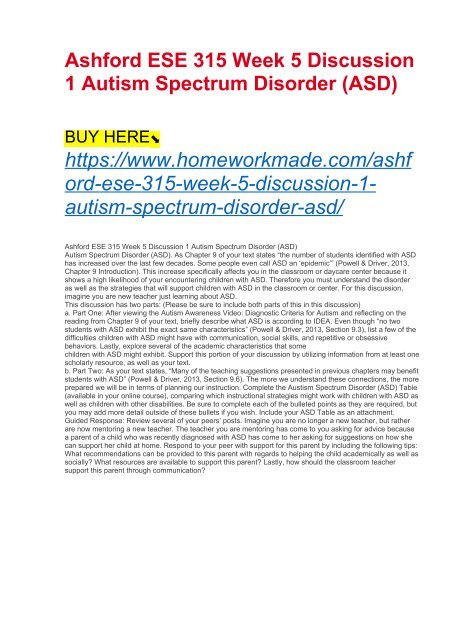Ashford ESE 315 Week 5 Discussion 1 Autism Spectrum Disorder (ASD)
Create successful ePaper yourself
Turn your PDF publications into a flip-book with our unique Google optimized e-Paper software.
<strong>Ashford</strong> <strong>ESE</strong> <strong>315</strong> <strong>Week</strong> 5 <strong>Discussion</strong><br />
1 <strong>Autism</strong> <strong>Spectrum</strong> <strong>Disorder</strong> (<strong>ASD</strong>)<br />
BUY HERE⬊<br />
https://www.homeworkmade.com/ashf<br />
ord-ese-<strong>315</strong>-week-5-discussion-1-<br />
autism-spectrum-disorder-asd/<br />
<strong>Ashford</strong> <strong>ESE</strong> <strong>315</strong> <strong>Week</strong> 5 <strong>Discussion</strong> 1 <strong>Autism</strong> <strong>Spectrum</strong> <strong>Disorder</strong> (<strong>ASD</strong>)<br />
<strong>Autism</strong> <strong>Spectrum</strong> <strong>Disorder</strong> (<strong>ASD</strong>). As Chapter 9 of your text states “the number of students identified with <strong>ASD</strong><br />
has increased over the last few decades. Some people even call <strong>ASD</strong> an ‘epidemic’” (Powell & Driver, 2013,<br />
Chapter 9 Introduction). This increase specifically affects you in the classroom or daycare center because it<br />
shows a high likelihood of your encountering children with <strong>ASD</strong>. Therefore you must understand the disorder<br />
as well as the strategies that will support children with <strong>ASD</strong> in the classroom or center. For this discussion,<br />
imagine you are new teacher just learning about <strong>ASD</strong>.<br />
This discussion has two parts: (Please be sure to include both parts of this in this discussion)<br />
a. Part One: After viewing the <strong>Autism</strong> Awareness Video: Diagnostic Criteria for <strong>Autism</strong> and reflecting on the<br />
reading from Chapter 9 of your text, briefly describe what <strong>ASD</strong> is according to IDEA. Even though “no two<br />
students with <strong>ASD</strong> exhibit the exact same characteristics” (Powell & Driver, 2013, Section 9.3), list a few of the<br />
difficulties children with <strong>ASD</strong> might have with communication, social skills, and repetitive or obsessive<br />
behaviors. Lastly, explore several of the academic characteristics that some<br />
children with <strong>ASD</strong> might exhibit. Support this portion of your discussion by utilizing information from at least one<br />
scholarly resource, as well as your text.<br />
b. Part Two: As your text states, “Many of the teaching suggestions presented in previous chapters may benefit<br />
students with <strong>ASD</strong>” (Powell & Driver, 2013, Section 9.6). The more we understand these connections, the more<br />
prepared we will be in terms of planning our instruction. Complete the Austism <strong>Spectrum</strong> <strong>Disorder</strong> (<strong>ASD</strong>) Table<br />
(available in your online course), comparing which instructional strategies might work with children with <strong>ASD</strong> as<br />
well as children with other disabilities. Be sure to complete each of the bulleted points as they are required, but<br />
you may add more detail outside of these bullets if you wish. Include your <strong>ASD</strong> Table as an attachment.<br />
Guided Response: Review several of your peers’ posts. Imagine you are no longer a new teacher, but rather<br />
are now mentoring a new teacher. The teacher you are mentoring has come to you asking for advice because<br />
a parent of a child who was recently diagnosed with <strong>ASD</strong> has come to her asking for suggestions on how she<br />
can support her child at home. Respond to your peer with support for this parent by including the following tips:<br />
What recommendations can be provided to this parent with regards to helping the child academically as well as<br />
socially? What resources are available to support this parent? Lastly, how should the classroom teacher<br />
support this parent through communication?

















